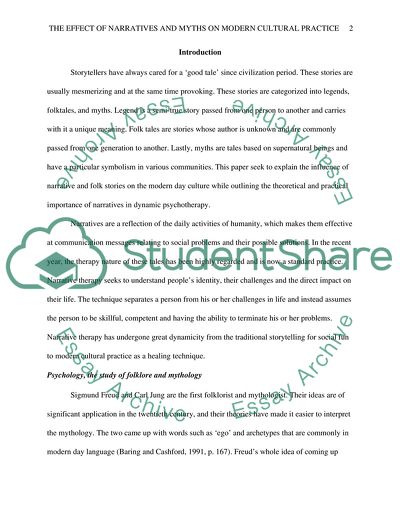Cite this document
(The Effect of Narratives, Myths, and Folktales on Modern Cultural Prac Essay, n.d.)
The Effect of Narratives, Myths, and Folktales on Modern Cultural Prac Essay. Retrieved from https://studentshare.org/culture/1864161-how-have-narrative-stories-myths-and-folk-tales-been-influential-in-modern-cultural-creative-practices-as-well-as-in-the-theory-and-practice-of-dynamic-psychotherapy-you-may-focus-on-one-or-two-categories-or-all-three
The Effect of Narratives, Myths, and Folktales on Modern Cultural Prac Essay. Retrieved from https://studentshare.org/culture/1864161-how-have-narrative-stories-myths-and-folk-tales-been-influential-in-modern-cultural-creative-practices-as-well-as-in-the-theory-and-practice-of-dynamic-psychotherapy-you-may-focus-on-one-or-two-categories-or-all-three
(The Effect of Narratives, Myths, and Folktales on Modern Cultural Prac Essay)
The Effect of Narratives, Myths, and Folktales on Modern Cultural Prac Essay. https://studentshare.org/culture/1864161-how-have-narrative-stories-myths-and-folk-tales-been-influential-in-modern-cultural-creative-practices-as-well-as-in-the-theory-and-practice-of-dynamic-psychotherapy-you-may-focus-on-one-or-two-categories-or-all-three.
The Effect of Narratives, Myths, and Folktales on Modern Cultural Prac Essay. https://studentshare.org/culture/1864161-how-have-narrative-stories-myths-and-folk-tales-been-influential-in-modern-cultural-creative-practices-as-well-as-in-the-theory-and-practice-of-dynamic-psychotherapy-you-may-focus-on-one-or-two-categories-or-all-three.
“The Effect of Narratives, Myths, and Folktales on Modern Cultural Prac Essay”. https://studentshare.org/culture/1864161-how-have-narrative-stories-myths-and-folk-tales-been-influential-in-modern-cultural-creative-practices-as-well-as-in-the-theory-and-practice-of-dynamic-psychotherapy-you-may-focus-on-one-or-two-categories-or-all-three.


